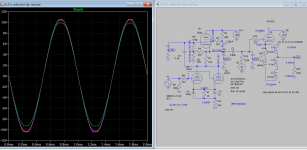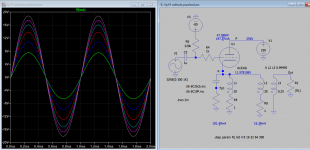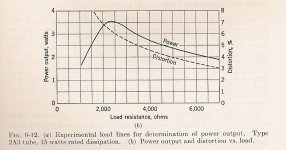No, it´s not an SS amplifier.
Dependson acrtual circuit details but expect between 60% and 70% output.
Dependson acrtual circuit details but expect between 60% and 70% output.
Assuming that the amp is sized correctly and acts as a (relatively) perfect voltage source, let's say we're outputing 8 volts.
V=I*R and P=V*I (or P=V^2/R)
Into a 4 ohm load that's 2 amps, and 16 watts. (peak, let's ignore all the RMS just for comparison)
Into a 8 ohm load that's 1 amp, and 8 watts.
So yes, half the power under ideal circumstances. But tube amps aren't ideal, they're designed to run at a specific load (the load is based on the winding ratio of the output transformer and the output impedance). Changing that means that the tubes are running on a different "load line", which is why some output transformers have different output taps so they can try to stay near the designed load line with differing loads. Generally, it's better to run a higher impedance than lower. Depending on the circuit, you might do a little better than half. If the tube amp is normally constrained by current, which most standard designs are, then there might be a little extra power available.
V=I*R and P=V*I (or P=V^2/R)
Into a 4 ohm load that's 2 amps, and 16 watts. (peak, let's ignore all the RMS just for comparison)
Into a 8 ohm load that's 1 amp, and 8 watts.
So yes, half the power under ideal circumstances. But tube amps aren't ideal, they're designed to run at a specific load (the load is based on the winding ratio of the output transformer and the output impedance). Changing that means that the tubes are running on a different "load line", which is why some output transformers have different output taps so they can try to stay near the designed load line with differing loads. Generally, it's better to run a higher impedance than lower. Depending on the circuit, you might do a little better than half. If the tube amp is normally constrained by current, which most standard designs are, then there might be a little extra power available.
Last edited:
It's a Conrad Johnson MV50 that I've owned for years. It sounds a little better into my current 8ohm speakers out of the 4ohm tap, but the speakers are pretty inefficient, so I was wondering about the headroom I would be losing. I finally know the answer to that question. Thanks, guys🙂
The load lines on the output tubes will be different, won't they? That could have an audible effect. Or would the feedback loop reduce that effect?
The higher the damping factor of the tube amp, the more the power will be reduced,
by connecting 8 Ohms to the 4 Ohm tap.
Except . . .
However, that is only true for an 8 Ohm Load Resistor.
A loudspeaker is not a Load Resistor.
A typical 8 Ohm loudspeaker, will have a minimum impedance that is equal to the DCR of the woofer. Often that is about 6 Ohms.
The minimum impedance typically is from 20Hz to either 30 Hz or 40Hz; and typically from 200 Hz to 400Hz.
If the impedance is 6 Ohms there, then switching the speaker from the 8 Ohm tap to the 4 Ohm tap, will Increase the power at those
minimum-impedance frequencies.
Generalization: "All Generalizations Have Exceptions"
by connecting 8 Ohms to the 4 Ohm tap.
Except . . .
However, that is only true for an 8 Ohm Load Resistor.
A loudspeaker is not a Load Resistor.
A typical 8 Ohm loudspeaker, will have a minimum impedance that is equal to the DCR of the woofer. Often that is about 6 Ohms.
The minimum impedance typically is from 20Hz to either 30 Hz or 40Hz; and typically from 200 Hz to 400Hz.
If the impedance is 6 Ohms there, then switching the speaker from the 8 Ohm tap to the 4 Ohm tap, will Increase the power at those
minimum-impedance frequencies.
Generalization: "All Generalizations Have Exceptions"
Last edited:
If it sounds better and plays loud enough to meet your needs it's fine. As pointed out speakers are not a flat impedance load over frequency.
In principle tube amps are ideal constant power sources. In practice this means that power delivery will not change drastically when load changes within a reasonable range.
It's not true they are designed for a specific load. Recommended operative conditions found in datasheets are normally for good/near max output power without trading off too much in linearity.
But I use a 10K plate to plate transformer in my 45 PP amplifier with only 8 secondary and can use any speaker rated from 4 to 8 ohm. Into 4 ohm I get more than 25% increase in output power. Max power is achieved into 3 ohm where primary load is just below the recommended value in datasheets...
But my current speakers are 8R with minimum 6R....I just like it more.
The other way round, if I run 8R from 4R secondary it's unlikely it will cut power by more than 30%. This might sound a lot but in reality isn't if the amp has sufficient power like the MV50 mentioned here.
However it will work better with more speakers, especially those that are rated 8R but have 4R minimum impedance.
It's not true they are designed for a specific load. Recommended operative conditions found in datasheets are normally for good/near max output power without trading off too much in linearity.
But I use a 10K plate to plate transformer in my 45 PP amplifier with only 8 secondary and can use any speaker rated from 4 to 8 ohm. Into 4 ohm I get more than 25% increase in output power. Max power is achieved into 3 ohm where primary load is just below the recommended value in datasheets...
But my current speakers are 8R with minimum 6R....I just like it more.
The other way round, if I run 8R from 4R secondary it's unlikely it will cut power by more than 30%. This might sound a lot but in reality isn't if the amp has sufficient power like the MV50 mentioned here.
However it will work better with more speakers, especially those that are rated 8R but have 4R minimum impedance.
The only case where I would avoid this practice without careful check is where the amplifier has pentode output stage. With triode and Ultra linear no problem. Triode especially is brilliant at driving high impedance.
Depending on output stage configuration, here is classic vs para-feed, the later has DCR 730 ohms.
Attachments
Last edited:
Depends on whether triode or pentode output. If triode, no problem, somewhat less power & less distortion.🙂
But if pentode output the screen(s) will have to dissipate a lot of power when the loadline runs up against to zero G1 line. That wuld be the dotted lines on the 6BQ5 plate family curves. And more D% is a sure thing at most levels.😱
But if pentode output the screen(s) will have to dissipate a lot of power when the loadline runs up against to zero G1 line. That wuld be the dotted lines on the 6BQ5 plate family curves. And more D% is a sure thing at most levels.😱
Attachments
- Home
- Amplifiers
- Tubes / Valves
- does running an 8 ohm load out of a 4 ohm tap cut output power in half



